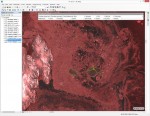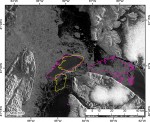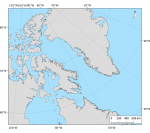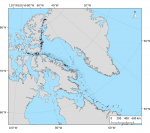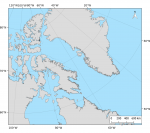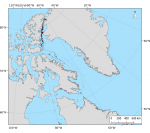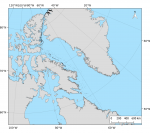Motion and deterioration of ice islands represented in the Canadian Ice Island Drift, Deterioration and Detection (CI2D3) Database. These ice islands are fragments of those that originally calved from the Petermann Glacier in 2008, 2010, 2011 and 2012, as well as from smaller calving events at other northwest Greenland floating ice tongues. The size of the ice island at the time of it’s observation is symbolized by the dot size. Animation courtesy of Greg Crocker.
The Canadian Ice Island Drift, Deterioration and Detection (CI2D3) database is a joint initiative between the Water and Ice Research Lab (Carleton University, Ottawa, Canada) and the Canadian Ice Service (Environment Canada) to digitize and catalogue major ice island calving events in Canadian waters for research purposes.
Ice islands are massive, tabular icebergs which calve from ice shelves and floating glacier tongues. The ability to identify, monitor and predict the drift and deterioration of these immense ice hazards is crucial for mitigating the associated risks to marine navigation and offshore infrastructure in their vicinity.
The Canadian Ice Island Drift, Deterioration and Detection project seeks to extract pertinent information from available satellite imagery and build a geospatial database for ice island drift and deterioration analyses, remote-sensing detection and model calibration and validation.
Implementation of the CI2D3 database is well-underway, starting with the influx of ice islands through eastern Canadian waters after massive calving events at the Petermann Glacier in 2008, 2010 and 2012. Thousands of archived RADARSAT-1 and -2 (Canadian Space Agency/MacDonald, Dettweiler and Associates) and Envisat (European Space Agency) synthetic aperture radar images are now being exploited to track ice islands until they are too small to delineate (< 0.25 km2).
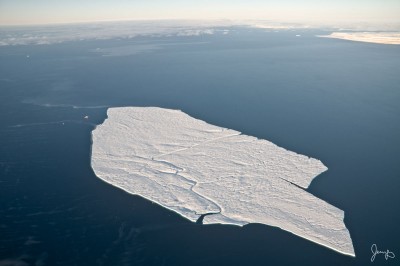
Peterman Ice Island (2010) PII-Ba in Lancaster Sound, October 2011. At the time, this ice island was 3 x 6 km, with a surface area of 12 km2 and a freeboard of approximately 15 m. Photo courtesy of Jessy Barrette.
Over 25,000 ice island polygons pertaining to the 2008, 2010 and 2012 events, as well as a smaller calving events at the Petermann Glacier (2011) and other northwest Greenland ice tongues have been delineated in ArcMap (ESRI) by operators using custom productivity tools. The relationship between each ice island and its daughter fragment(s) is captured to permit spatio-temporal studies of fracturing. The geodatabase was expanded by digitizing ice islands generated from the Petermann Glacier calving in 2012 with funding from Polar Knowledge Canada. We are also seeking funding to extend this database to include the drift of ice islands from the ice shelves of northern Ellesmere Island to the Beaufort Sea and beyond.
We expect this database to be an extremely valuable resource for offshore stakeholders, researchers, Arctic communities and policymakers. For the first time we have an account of the drift, fragmentation, and decay of major Arctic ice islands from their formation to disintegration, at unprecedented spatial and temporal resolution.
- A screenshot of the digitizing work environment in ArcMap (ESRI) and ice islands (green outlines) in northern Baffin Bay on October 9, 2010. A custom toolbar includes access to the fields required for data entry. Ice island PII-A (74 km2) is on the left while ice island PII-B (right) has just broken into 3 fragments: PII-B (85 km2), PII-B-a (33 km2) and PII-B-b (11 km2). Radarsat-2 data and products © MacDonald, Dettwiler and Associates Ltd., 2010 – All Rights Reserved.
- The original Petermann Ice Island in 2010 (pink), drifted out of Petermann Fiord and broke into two pieces (yellow) on Joe Island in Kennedy Channel, September 9, 2010. The CI2D3 database recorded the relationship between ‘mother’ (PII: 248 km2 as of September 9) and ‘daughter’ fragments, PII-A (85 km2) and PII-B (158 km2) to the south and north, respectively. Radarsat-2 data and products © MacDonald, Dettwiler and Associates Ltd., 2010 – All Rights Reserved.
- A map of the ice islands from the 2008 Petermann Glacier calving event. On July 13, 2008, a 36.7 km2 of ice calved from the Petermann Glaicer, northwest Greenland. By July, 2009 all the ice islands produced had broken into fragments too small to detect. 332 polygons were digitized from 177 images to document this event. Note that satellite imagery was less frequent in September and October 2008.
- A map of the ice islands from the 2010 Petermann Glacier calving event. On August 5, 2010 302 km2 of ice calved from Petermann Glacier, northwest Greenland. By December 31, 2013, 9658 polygons were observed in 3020 images as far south as Newfoundland.
- A map of the ice islands from the 2011 Petermann Glacier calving event. On August 16, 2011 4.4 km2 of ice calved from Petermann Glacier, northwest Greenland. By October 2012,502 polygons were observed in 489 images.
- A map of the ice islands from the 2012 Petermann Glacier calving event. On July 17, 2012 150 km2 of ice calved from Petermann Glacier, northwest Greenland. By December 31, 2013, 7263 polygons were observed in 1538 images.
- A map of the ice islands that originated from Northwest Greenland Glaciers, but not the Petermann Glacier (including Ryder, Steensby, C.H. Ostenfeld, glaciers, etc.). These were digitized from August 2011 to December 31, 2013. A total of 7573 polygons were digitized from hundreds of images account for the loss of over 500 km2 of ice from these glaciers.
For more information
CI2D3 is led by Derek Mueller, a professor at the Geography and Environmental Studies department at Carleton University. You may contact him at derek.mueller@carleton.ca.
Downloads & Resources
The data and metadata for this project can be found in the Polar Data Catalogue (Record Number 12678).
Suggested citation:
Data citation:
Desjardins, L., Crawford, A., Mueller, D., Saper, R., Schaad, C., Stewart-Jones, E., and Shepherd, J. (2018) Canadian Ice Island Drift, Deterioration and Detection Database (CI2D3 Database) [v1.1]. Waterloo, Canada: Canadian Cryospheric Information Network (CCIN). DOI: 10.21963/12678
Document of Record:
Crawford A., Crocker G., Mueller D., Desjardins L., Saper R., and Carrieres T. (2018) The Canadian Ice Island Drift, Deterioration and Detection (CI2D3) Database. Journal of Glaciology 64(245):517-521. DOI: 10.1017/jog.2018.36
Documentation:
Crawford, A., Desjardins, L., Saper, R., Mueller, D., Stewart-Jones, E. 2018. Canadian Ice Island Drift, Deterioration and Detection (CI2D3) Database Documentation [v1.1] Water and Ice Research Laboratory, Carleton University, Ottawa. 19 pp. https://doi.org/10.22215/wirl/2018.1
People and Funding
Contributors to the CI2D3 database include: Derek Mueller, Luc Desjardins, Anna Crawford, Ron Saper, Emilie Stewart-Jones, Jeff Shepherd, Correy Schaad, Gregory Lewis-Paley, Sougal Bouh Ali, Adam Garbo, Eslam Alhogaraty, and students of Advanced Topics in GIS (GEOM 4008) in 2015 and student of Applications in GIS (GEOM 4009) in 2017.
This project was undertaken with the financial support of:
![]()
Publications
Crawford, A.J., Crocker, G., Mueller, D., Desjardins, L., Saper, R., and Carrieres, T. 2018. An introduction to the Canadian Ice Island Drift, Deterioration and Detection (CI2D3) Database. Journal of Glaciology 64(245):517-521. DOI:10.1017/jog.2018.36
Crawford, A.J., Mueller, D., Desjardins, L., Myers, P.G. (2018). The aftermath of Petermann Glacier calving events (2008-2012): Ice island size distributions and meltwater dispersal. Journal of Geophysical Research – Oceans 123():. DOI:10.1029/2018JC014388
Crawford, A.J., P. Wadhams, T.J.W. Wagner, A. Stern, E.P. Abrahamsen, I. Church, R. Bates, and K.W. Nicholls. 2016. Journey of an Arctic ice island. Oceanography 29(2):254 – 263. DOI:10.5670/oceanog.2016.30.

